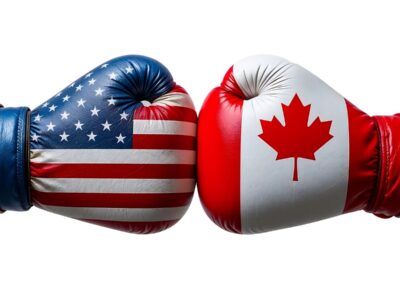OPINION: Don’t panic, Canada. Rushing into a deal with Trump would be our worst mistake

Boxing gloves with US and Canadian flags symbolize the trade war between the two countries.
This article was originally published in the Globe and Mail. To see the original article click here.
Is Canada about to make it through the worst of what a Trump administration can bring?
That may be an odd question given Tuesday’s announcement by U.S. President Donald Trump of a 50-per-cent tariff on copper, adding to a seemingly endless series of bad-to-worse news from Washington on trade.
However, there is a larger, more significant change working its way through U.S. courts to which we should be paying attention. This change will either limit the President’s ability to impose tariffs on Canada – or reinforce it. This means Canada should not rush into a deal with Mr. Trump and should instead wait it out.
Recall that, on May 28, a panel of the U.S. Court of International Trade, including a Trump-appointed judge, unanimously and decisively ruled that the administration’s use of the International Emergency Economic Powers Act to impose what in essence have become whatever-whenever-wherever-however-on-whomever tariffs, at the snap of the President’s finger, is unconstitutional and that the tariffs imposed using this power should be struck down. (A separate suit in a U.S. District Court also ruled against the administration’s use of emergency powers to impose tariffs.)
This ruling on tariffs issued under the IEEPA struck down the fentanyl and immigration tariffs on Canada, China and Mexico, as well as the “Liberation Day” tariffs. The ruling is on hold while the case is being appealed, potentially all the way to the Supreme Court. But the appeals court has put the case on an expedited timeline and is set to hear arguments on July 31.
If the appeals court or the Supreme Court reverses the U.S. Court of International Trade’s ruling, then the courts will have given the current and future administrations explicit, rather than assumed, legal sanction to tariff whenever, wherever, however and whomever they want.
But if the ruling is upheld, the tariffs issued on the President’s sole authority, such as fentanyl and “Liberation Day” tariffs, as well as future threats, would end.
This is important. Even though Mr. Trump has already chosen to exclude products traded under the Canada-United States-Mexico Agreement from these IEEPA tariffs, that exemption is based on presidential whim; should the President change his mind, those tariffs could reappear. The court ruling, if upheld, would remove the threat of those tariffs entirely.
As bad as Tuesday’s announcement on copper was, a decision by the President to change his mind on the CUSMA exemption for his global tariffs would be worse.
In a side note, the Trump administration has already conceded in legal filings that importers who have paid IEEPA tariffs will be eligible for refunds, including interest, if the U.S. Court of International Trade’s decision survives appeal.
This is obviously a momentous ruling for Americans and Canadians and needs to be unpacked, especially in light of Tuesday’s announcement.
A U.S. president has several powers, all delegated from Congress, that can be used to impose tariffs. The IEEPA has been the most far-reaching and hence the most consequential and damaging. The recent rulings against its use will not bring relief or certainty to Canadian steel and aluminum and the seven items, including copper, on the current list of products under investigation for tariffs under Section 232 of the Trade Expansion Act of 1962.
The distinction between IEEPA tariffs and Section 232, or steel and aluminum tariffs, is hugely important.
Section 232 and other non-IEEPA tariff measures require an investigation, public comment and the issuance of a report, all of which turn a “snap of the fingers” act into a drawn-out, politicized, public process. The Section 232 investigation into steel and aluminum took nearly 270 days. Copper took a few months, but the investigations all take time.
Furthermore, these tariffs are applied at the four-digit level of classification under the U.S. Harmonized Tariff Schedule, which has more than 1,220 four-digit headings.
The political and regulatory math is not in the President’s favour for widespread use of this or other IEEPA substitutes.
There is still the potential for real economic harm from the use of other tariff measures, as we have seen. However, it is critical to put this in perspective. As bad as Tuesday’s news may be, a handful of items, each individually investigated and taking almost a year to implement, are not the tariff threat that is the everything, everywhere and all at the snap of the President’s fingers tariffs.
For Canada and other countries, if the ruling stands, Mr. Trump’s negotiating leverage will be weakened – both in imposing new tariffs and threatening to, in effect, abrogate agreements by imposing new tariffs at will.
If his favourite and easiest tool for imposing tariffs is constrained and the current fentanyl and across-the-board tariffs are about to be revoked, then it’s a whole new ball game and Canada needs to change its negotiating objectives and strategy.
Step 1 is to pause making any further concessions or signing agreements until the court cases play out. There is little sense in making concessions to end tariffs that are likely to be revoked. Second, signing agreements now, when the President still has a strong hand, makes even less sense.
For example, Canada already has, or thought it had, an agreement to end the steel and aluminum tariffs. But in his second term, Mr. Trump reneged on the agreement he signed in his first term without adhering to any of its conditions.
With steel and aluminum tariffs, what Canada needed was not an agreement to temporarily suspend the tariffs; it needed an exemption to prevent the use of presidential power to impose them. The administration’s expansion of Section 232 tariff investigations to other products makes this point. This reneging on an agreement by Mr. Trump, of course, also applies to the North American trade agreement he negotiated.
Neither agreements nor the President’s word will protect us; only U.S. law and regulations that constrain the President will.
In other words, the goal for negotiations is a binding commitment and U.S. law that prevents, limits or conditions the use of the presidential tariff authority.
Not having this sort of concession is an explicit acknowledgment that, like the steel and aluminum agreement, sooner or later, any deal will not be worth the paper on which it is written.
Carlo Dade is Director of International Policy at the School of Public Policy at the University of Calgary.


